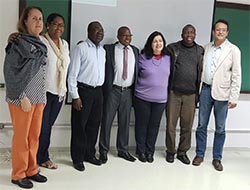Genetic and symbiotic characterization of indigenous rhizobia
The objectives of this study were to characterize indigenous rhizobia and to identify strains that hold potential to be included in inoculants for soyabean production in Mozambique. Rhizobia isolates were sampled from promiscuous soyabean varieties at 15 locations and were taken to Brazil. A total of 105 isolates were screened for symbiotic effectiveness in the greenhouse along with four strains used in inoculants in Brazil, Bradyrhizobium japonicum SEMIA 5079, B. diazoefficiens SEMIA 5080, B. elkanii strains SEMIA 587 and SEMIA 5019, and one strain used in Africa, B. diazoefficiens USDA 110. The genetic and symbiotic characterization were based on the 87 isolates that nodulated the non-promiscuous soyabean cultivar BRS 133 in the screening experiment. The genetic analyses were based on BOX-PCR profiling of the genomic DNA and 16S rRNA gene sequencing. BOX-PCR analysis revealed great genetic diversity with a total of 41 phylogenetic groups found and the 16S rRNA gene sequencing analysis clustered the 87 isolates in Bradyrhizobium (75%) and Agrobacterium – Rhizobium (25%) clades.
In relation to symbiotic effectiveness, great variability was detected among the native rhizobia from Mozambique with 10 isolates performing better than USDA 110, the best reference strain, and 50 isolates with lower performance than all the reference strains. Thirteen of the best performing isolates were selected for a second greenhouse experiment with two promiscuous (TGx 1963-3F and TGx 1835-10E) and one non-promiscuous (BRS 284) soyabean varieties and the five reference strains. Five isolates consistently exhibited superior symbiotic effectiveness suggesting that the inoculation of soyabean with indigenous rhizobia adapted to local conditions is strategic for soyabean production in Mozambique. Multi-location field experiments with those promising isolates will be conducted to ascertain their superiority in fixing N2 in the presence of other indigenous and/or commercial strains.
Feasibility of transference of inoculation-related technologies from Brazil to Mozambique
To study the feasibility of transferring inoculation-related technologies from Brazil to Mozambique, the elite rhizobia strains used in the previous experiments were tested in field experiments conducted with non-promiscuous soyabean genotypes in Brazil (four sites) and Mozambique (five sites) in the 2013/2014 and 2014/2015 crop seasons. The best inoculation treatments across sites and crop seasons in Brazil were SEMIA 5079, SEMIA 5080 and USDA 110, with average grain yield gains of 4–5% in relation to the non-inoculated (NI) treatment. SEMIA 5079, SEMIA 5080, SEMIA 5019 and USDA 110 were the best performing strains in Mozambique, with average 20–29% grain yield gains over the NI treatment. These results suggest the feasibility of transference of inoculation-related technologies between countries with similar agro-climatic conditions.
Co-inoculation of soyabean with Bradyrhizobium and Azospirillum
The objective of this study was to ascertain the effect of co-inoculating soyabean with Bradyrhizobium and Azospirillum on the precocity of nodulation. The study was first conducted in the greenhouse and the successful result was confirmed in the field. In both experiments, conducted in Brazil, co-inoculated soyabean nodulated precociously, suggesting that the presence of Azospirillum helps plants to overcome environmental stresses.
Conclusion and recommendation
High genetic and symbiotic diversity was detected among the indigenous rhizobia from Mozambique. Five isolates consistently showed high N2-fixation effectiveness, suggesting that inoculation with rhizobia adapted to local conditions is a possible strategy for soyabean production in Mozambique. Multi-location field experiments should be conducted in Mozambique to confirm the performance of those strains.
In the two-season field experiments conducted in Brazil and Mozambique, strains SEMIA 5079, SEMIA 5080 and USDA 110 showed great potential to be included in inoculants in both countries. The results confirm the feasibility of transference of inoculation-related technologies in soyabean between countries with similar agro-climatic conditions.
|
USDA 110 was the best reference strain in the greenhouse experiments and had an excellent performance in the field experiments conducted in Mozambique and Brazil, including at Londrina where this strain was inoculated for the first time and there was a rhizobial population of over 105 cells g−1 of soil. Interestingly, some indigenous isolates from Mozambique had similar or better performance than USDA 110 in the greenhouse experiments, which opens a window of research opportunities with those rhizobia. I successfully defended my thesis in June 2016 (Figure 1). |
Figure 1. Amaral Chibeba (center) and from left to right, Dr. Maria Guimarães (UEL – Brazil, Supervisor), Dr. Adriana da Silva (UEL – Brazil, Thesis Evaluation Panel Member), Dr. Steve Boahen (IITA – Mozambique and N2Africa, Supervisor), Dr. Mariangela Hungria (Embrapa – Brazil, Supervisor), Dr. Felix Dakora (Tshwane University of Technology – South Africa, Thesis Evaluation Panel Member) and Dr. Marco Nogueira (UEL – Brazil, Thesis Evaluation Panel Member) |
Amaral Machaculeha Chibeba, State University of Londrina (UEL), Brazil (Click here for his 2015 update)

